Major-General Sir Isaac Brock is a rather impressive figure in the mythos of Canada. The unwilling lieutenant governor of the armpit of the British Empire, a man who longed for battle against the French and general thorn in the side of the Governor General. Brock would find himself elevated to the level of Folk Hero after he lied his way to victory against a demoralized and drunk American General. And despite nearly losing Upper Canada at Queenston still to this day wears the mantle of the Saviour of Upper Canada.
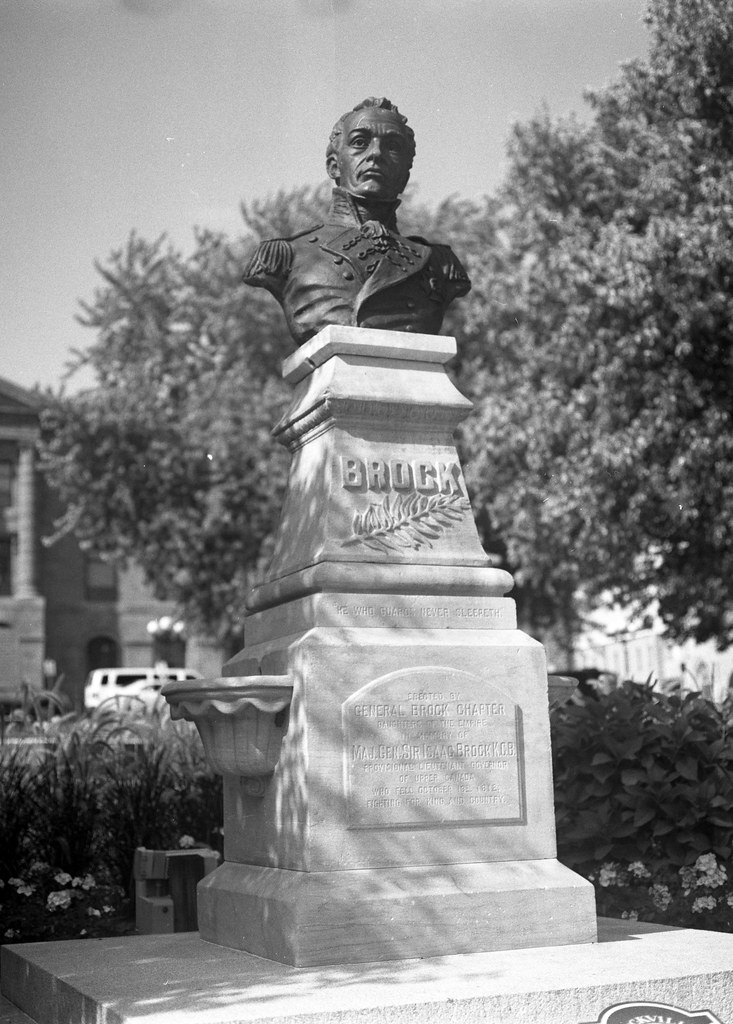
A bust of Sir Isaac Brock in downtown Brockville, Ontario. The town changed its name to honour the General.
Pentax 645 – SMC Pentax A 645 75mm 1:2.8 – Kodak Plus-X Pan (PXP) – Kodak TMax (1+4) 5:45 @ 20C
Born on the British Channel Island of Guernsey in 1769, Isaac Brock was the eighth son in a wealthy family. Even at a young age, Brock stood tall, robust, and athletic; he also had a kind and gentle temperament. Something that at initial reaction would not serve him well in his choice of career, for Brock joined the British Army. At 15 he joined the 8th (The King’s) Regiment of Foot as an ensign. Gaining valuable combat experience, he found himself at 28 the Lieutenant Colonel of the 49th Regiment of Foot. He proceeded to reorganize the unit into a top-notch fighting force. He gained more experience in combat, distinguishing himself at the Battle of Egmont-op-Zee in 1799, and ended up with a wound while fighting alongside Sir John Moore. Two years later, Brock was given second-in-command of the land forces during Nelson’s attack on Copenhagen.
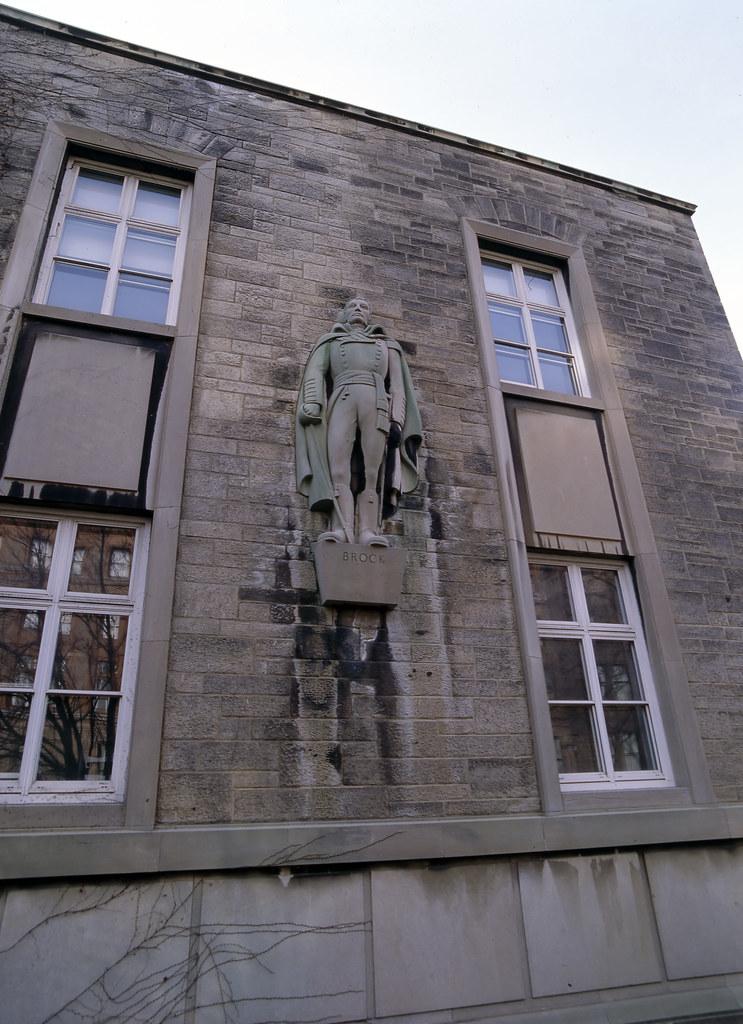
A statue honouring General Sir Isaac Brock located at the University of Toronto near Queen’s Park along with several other major figures in Canadian History.
Pentax 645 – SMC Pentax A 645 35mm 1:3.5 – Kodak Ektachrome E100G – Processing By: Old School Photo Lab
By 1802 the fighting in Europe had come to an end. Brock and the 49th would be ordered to Lower Canada to take up post at Quebec City. Upon arrival, Brock was brought onto the Governor General’s staff and requested to assess and improve the defenses of the colony. During his time, Brock would face one of the biggest threats to the British army in the colony, that of desertion and poor discipline. Both of which Brock dealt with in a swift and often brutal fashion. He would send troops across the border to recapture those who tried to flee and came to the aid of Roger Hale Sheaffe to defuse an attempt at mutiny. A swift promotion through Colonel to Brigadier General through 1806 and 1807 saw Brock given the position of military governor and head of the executive of Upper Canada as the Lieutenant Governor, Francis Gore, had taken ill back to England. With this new role and the declining relationship between the United States and England, Brock took it upon himself to improve the defense of the colony by establishing both a colonial militia and improvement to the fortifications. Brock also sought out the natives to improve relations and bring them over to the side of the Crown should an American invasion happen.
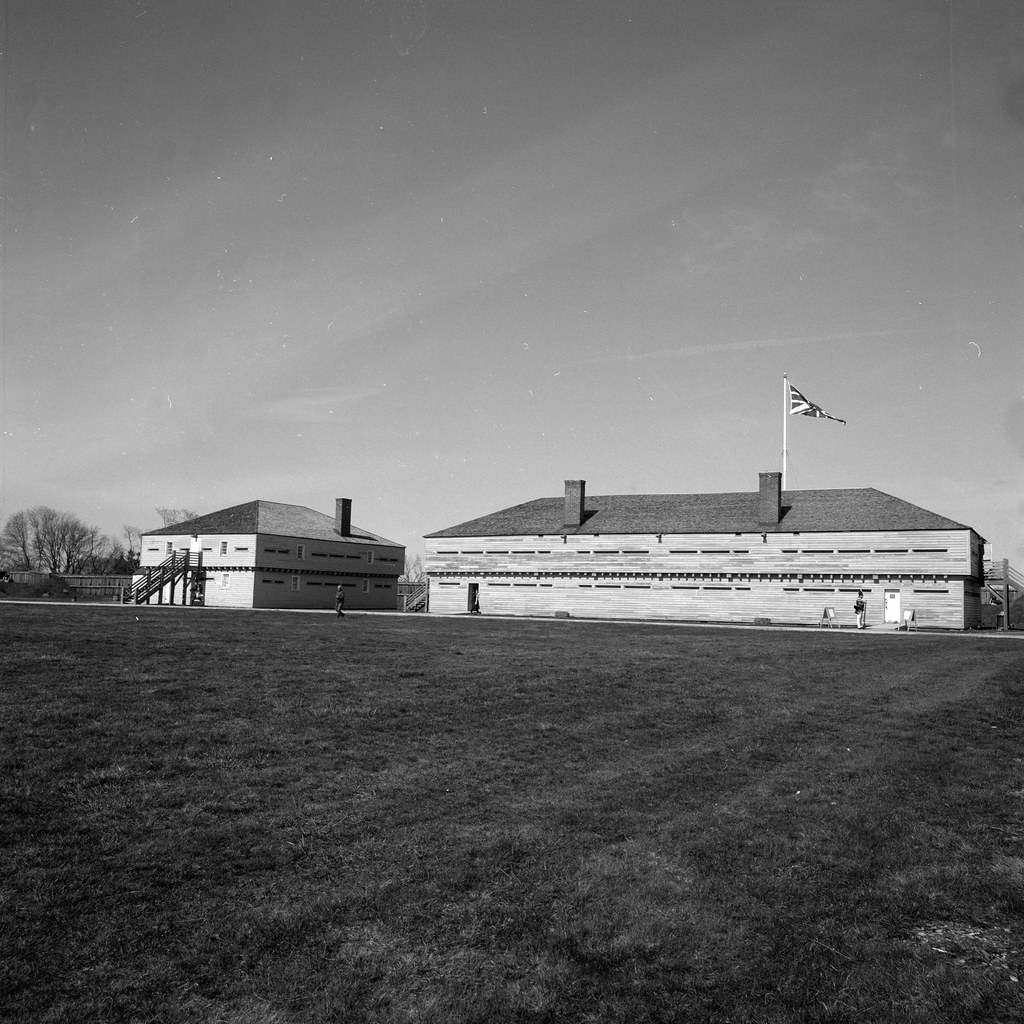
Fort George in Niagara-On-The-Lake, Ontario remained Brock’s preferred headquarters during his posting to Upper Canada, rather than the capital of York (Toronto).
Hasselblad 500c – Carl Zeiss Distagon 50mm 1:4 – Rollei RPX 100 @ 100 – Rollei RPX-D (1+15) 6:30 @ 20C
When the United States declared war against England in the summer of 1812, Brock was disappointed in his orders from the newly appointed Governor General, George Prevost. Brock was to take a defensive standpoint. An act he feared would only improve the American chances of overrunning the territory of Upper Canada while Prevost remained behind the thick walls of Quebec City. Brock supported the idea that a strong defense is a strong offense. And the years spent cultivating relationships with the fur traders and natives gained him a wide network of agents. With these agents, he kept even the most distant posts notified of the state of war. He even went as far to order Captain Charles Roberts to capture the American post at Mackinac Island, an action that put him directly at odds with Prevost. This network also allowed for the capture of the American ship Cuyahoga Packet as the British knew of the state of War while the Americans did not. The cargo hold of the American ship yielded the full American war plan.
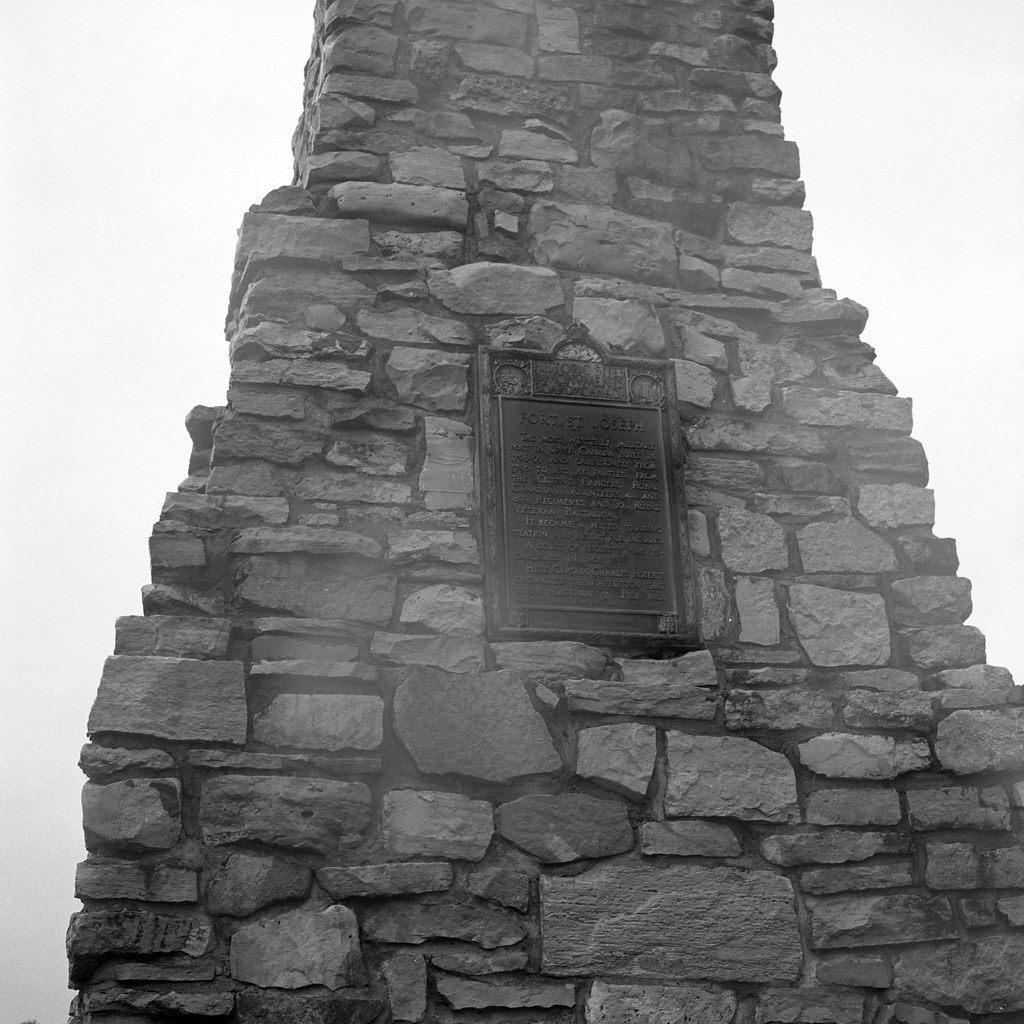
The ruins of Fort St. Joseph near Sault Ste. Marie, while Brock never visited the post, it was from here his first action launched.
Rolleiflex 2.8F – Carl Zeiss Planar 80mm 1:2.8 – Kodak Tri-X 400 (400TX) – Kodak Xtol (1+1) 9:00 @ 20C
When this information came to Brock, he quickly assembled as many regular, provincial, and militia troops as he could muster and headed for the Detroit Frontier. The arrival of troops forced the American General Hull back across the river. It was at Fort Amherstburg that Brock would meet his equal, the Shawnee War Chief Tecumseh. Both men of action they plotted the downfall of Hull’s army. And in a brilliant move forced the American surrender through surprise, fear, and outright lies. It was the capture of Detroit that earned Brock the title of the Savour of Upper Canada and a knighthood.
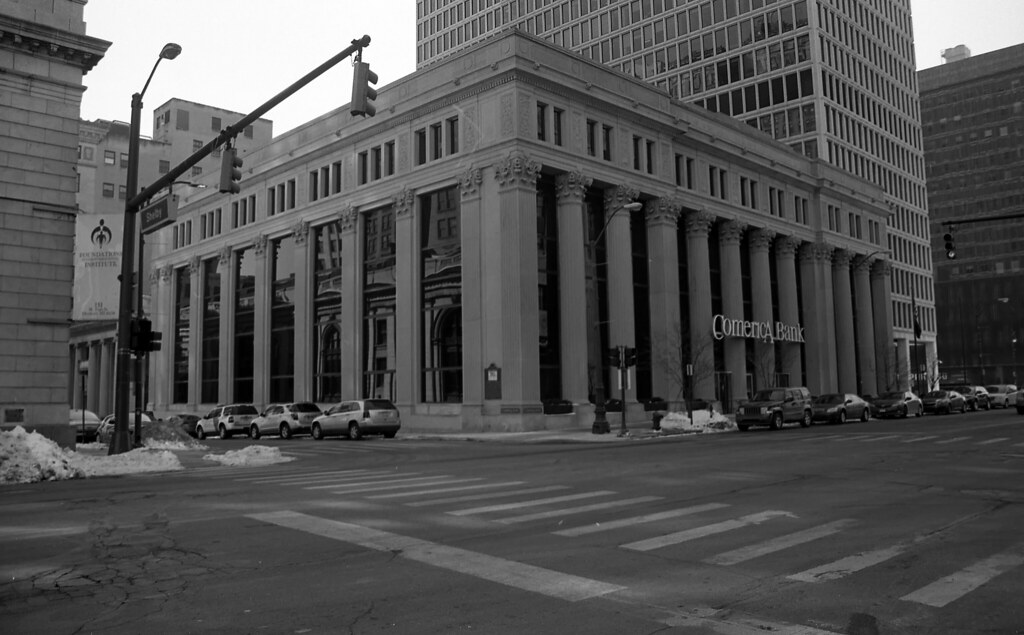
The former site of Fort Detroit now makes up the intersection of Fort and Shelby Streets in downtown Detroit, Michigan.
Nikon F4 – Nikon Series E 28mm 1:2.8 – Afga APX 100 – Kodak Xtol (1+1) 9:45 @ 20C
As Brock sailed back to Fort George, a disturbing report reached the general a temporary cease-fire, arranged by Prevost through General Sheaffe along the Niagara frontier. While many viewed this as a pathway to peace, Brock saw it differently. Upon his arrival, it was as he feared, his hands were tied only to watch an American invasion force grow across the river at Lewiston. Even his spies could not tell him where or when a potential invasion would happen. Peace never came, and when the cease-fire expired Brock could no longer invade upstate New York, and he would quickly deploy his troops along the river hoping to keep the Americans at bay. It didn’t, and in the gray early morning under a light drizzle, the first Americans crossed the river at the village of Queenston. Brock was roused with the sound of cannon fire and rode without escort towards the village. By the time he arrived the Americans had successfully pushed the British off the heights. Brock proceeded to rally the troops and lead an abortive charge up the hill, leading from the front. As the troops faltered he turned to the men of his former command, the light and grenadier companies of the 49th. A quick rebuke was all that they needed, and they charged again. An American Rifleman hidden in the trees took the shot, and Brock fell, dead. While some legends claim he managed to shout ‘Push on brave York volunteers’ an account by a young soldier states that Brock fell instantly never breathing a word.
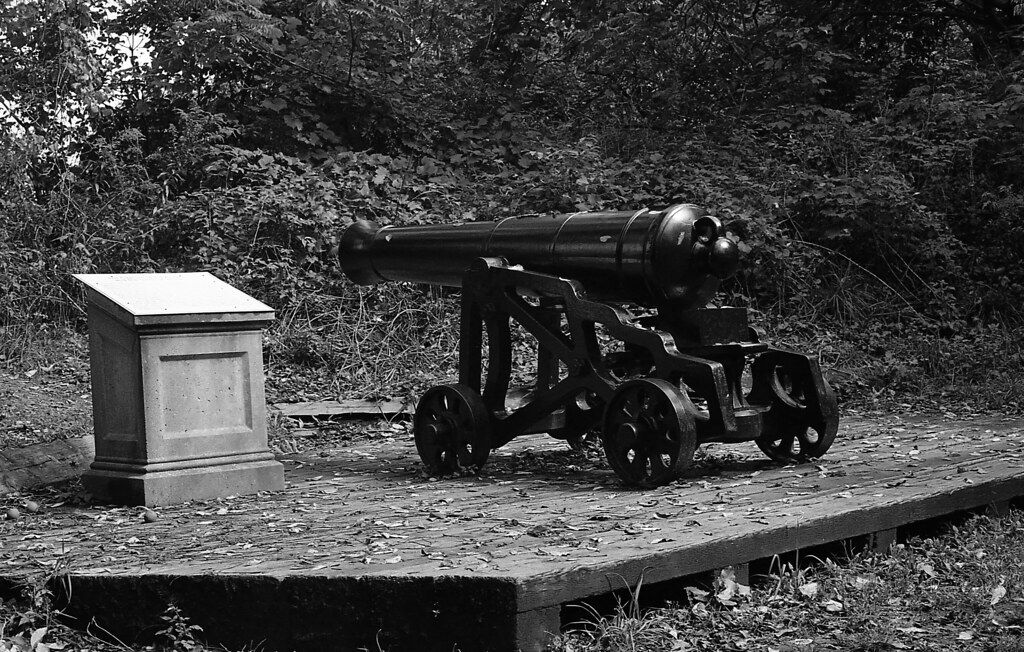
The Ridan Battery at Queenston Heights close to the spot where Brock died, it also provided the heaviest fire against the American landing craft.
Nikon FM2 – AI-S Nikkor 50mm 1:1.4 – Kodak Tri-X 400 – HC-110 Dil. B 4:30 @ 20C
While the American invasion would be repulsed, it was through the efforts of Roger Hale Sheaffe, not Brock., and while Sheaffe was the hero of the day, it was his next actions at the Battle of York that saw his reputation tarnished. Brock’s funeral on the 16th would see Regular, Provincial, Native, and militia troops line the parade route to Fort George, where Brock’s body entombed in one of the bastions. A twenty-one gun salute fired by the fort’s artillery battery, even Fort Niagara on the American side of the river fired a similar salute to the fallen general. Brock’s actions spread like wildfire across Upper Canada, the village of Elizabethton changed its named to Brockville (a name it retains to this day), and a twenty-gun sloop named in his honour. Following the war, a monument to the general rose from Queenston Heights and his body reinterred beneath it. The monument became the target of an act of terror in 1840 and would be rebuilt to the impressive column it is today in 1853 as the tallest war memorial in Canada. Today you can find a road or street bearing Brock’s name in most Ontario towns and cities, even a University, Brock University in St. Catherines, Ontario bears his name and a statue on campus to the general.
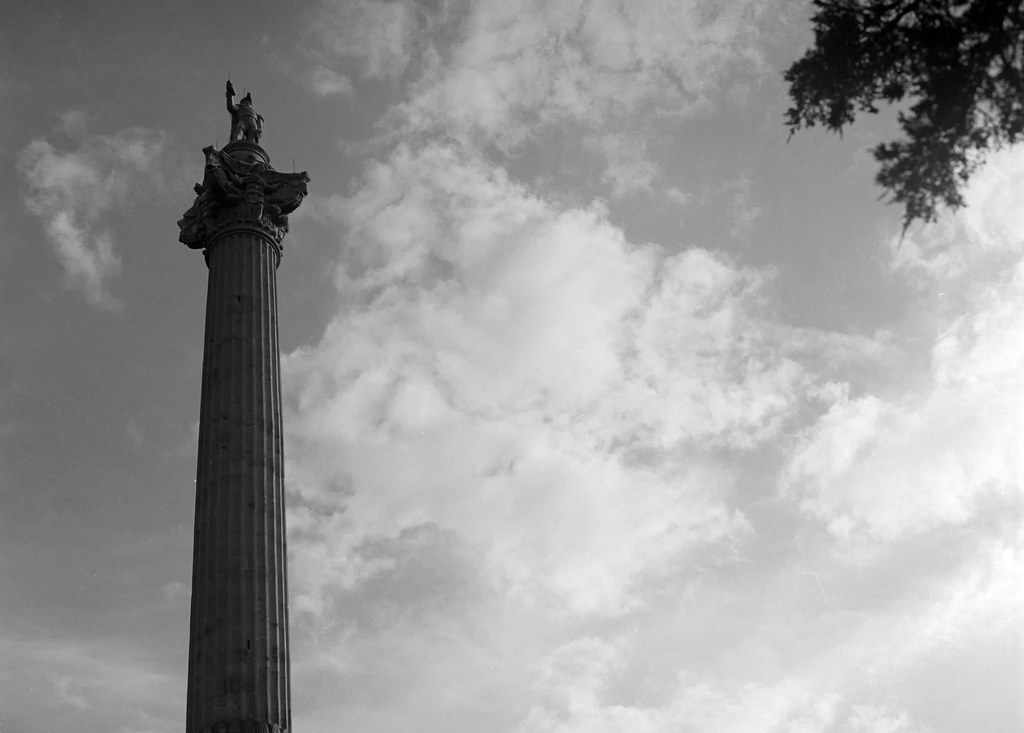
Brock’s monument is hard to miss when crossing at Queenston/Lewiston or driving along the Niagara Parkway. The monument is open to the public and you can climb to the top.
Pentax 645 – SMC Pentax A 645 75mm 1:2.8 – Kodak Tri-X 400 – Kodak HC-110 Dil. B 6:00 @ 20C
Written with files from:
Web: www.warof1812.ca/brock.htm
Hickey, Donald R. Don’t Give up the Ship!: Myths of the War of 1812. Urbana: U of Illinois, 2006. Print.
Berton, Pierre. The Invasion of Canada, 1812-1813. Markham, Ont.: Penguin, 1988. Print.